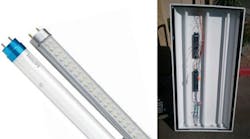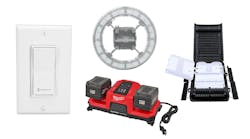More than half of all the light sources in our country’s offices, classrooms, and other commercial spaces are linear fluorescent tubes, which can be found in a range of fixtures, including 2 ft × 4 ft, 2 ft × 2 ft, and 1 ft × 4 ft troffers. But a growing number of LED products are being offered as energy-efficient alternatives to linear fluorescent tubes — including T8 LED replacement lamps, integral LED luminaires (2 × 4 and 2 × 2), and kits to modify fluorescent troffers to use non-tube LED light sources. Earlier this year, the U.S. Department of Energy’s (DOE) CALiPER program released the results of an exploratory study on the problems and benefits likely to be encountered as these LED products become increasingly popular.
A realistic mock-up
Two dozen identical pairs of troffers were tested for luminous flux, color, power quality, and photometric flicker before being evaluated in a simulated office space by 18 facility engineers and lighting designers. Three of the tested pairs consisted of fluorescent benchmark troffers, five were fluorescent troffers retrofitted with LED T8 lamps, four were LED non-tube retrofit kits, and 12 were integral LED troffers.
The study showed considerable improvement over the last CALIPER tests on such products, which were conducted in 2011. Overall, the LED luminaires tested in the newest study were found to be slightly more efficacious than their fluorescent counterparts — which averaged 59.6 lm/W, compared with 80.3 lm/W for the LED products. But several areas of concern were identified.
Performance issues. One was color consistency. Even though most of the LED troffers were claimed by their manufacturers to be 4000K white, their actual color was found to vary from manufacturer to manufacturer. Another concern had to do with glare. Some of the fixtures that had dramatic or odd brightness patterns on the lens or diffuser were perceived as producing more glare and causing more noticeable reflections on glossy computer screens — an effect that was more pronounced with LEDs than with fluorescents, especially when the appearance of the troffer lens hadn’t been carefully considered by the manufacturer.
Another issue noted by the study was that most LED T8 replacement lamps — which, unlike omnidirectional fluorescent tubes, emit no light from their back sides — caused the appearance of stripes on the lenses of troffers by increasing the luminance contrast between the lamp and the unlighted reflector behind it. As for dimming, neither the LED products nor the fluorescents were found to dim smoothly and predictably, and roughly one-third of the LED products exhibited annoying flicker in dimmed mode.
Installation concerns
A number of issues were encountered during the installation of the LED products. For LED retrofit tubes, there wasn’t enough wire in some troffers to reach across the fixture, once the ballast was cut out. Some LED tubes came with stickers to warn against reinstalling T8 fluorescent tubes in the modified fixture, but electricians didn’t use those stickers if the instructions made no mention of them. LED tubes from two manufacturers featured rotatable pins in the socket to orient the tubes inside the troffer, but seating and rotating the tubes in the socket was found to be quite challenging. Some kits lacked sleeving or other pieces that were referred to in the instruction sheets. The catalog numbers of one manufacturer were at variance with the numbers on the actual products.
For LED non-tube retrofit kits, those that directed the installer to discard the fluorescent sockets (“tombstones”) and install bars of LEDs instead of tubes were found to require a lot less labor than reusing the sockets. One kit provided stranded wire for push connectors, despite the fact that solid wire would not only have been easier to install but would have provided a more secure connection. Another kit had a different manufacturer’s name on the instruction sheets from the name on the actual hardware. The need for some non-tube retrofit kits to be installed in deeper troffer housings wasn’t noted prominently enough on the specification sheet. Some lenses and surfaces came with protective film to minimize scratching, but the instructions suggested removing the film before the risk of scratching was eliminated. Overall, an electrical inspector could have disqualified more than half of the installed LED tubes and non-tube LED retrofit kits because of either poor assembly or lack of safety documentation.
Much improvement
The CALiPER study shows that LED-dedicated troffers can compete with fluorescents, but it highlights some concerns with LED replacement tubes and non-tube retrofit kits. While many of these concerns were due to the fact that the existing housings were designed for omnidirectional fluorescents rather than for directional LEDs, it’s advisable to mock up and visually evaluate LED retrofit products before ordering them for large installations.
Although there have been significant improvements in this class of LED products, they have a ways to go before they become a “no-brainer” choice over their fluorescent counterparts. For a copy the full CALiPER report, visit www.ssl.energy.gov/exploratory.html. A new, follow-up CALiPER study on LED T8 replacement tubes is currently underway, with the results expected in the next few months.
Brodrick, Ph.D., is the solid-state lighting portfolio manager for the U.S. Department of Energy, Washington, D.C. He can be reached at [email protected].




